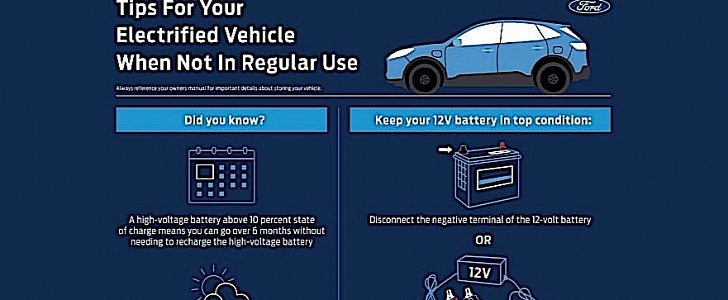Despite the fact some states have begun easing restrictions, there’s a good chance we’ll be forced to shelter in place for a while longer. That means most of the cars will have to spend some more time parked and unused.
Whereas for those driving a conventional ICE-powered car this doesn’t come with too many strings attached, for electrified owners things might be a bit more complicated.
In an attempt to teach owners how to tend to their vehicles during these times, Ford’s senior technical leader for Battery and Cell System Development Bob Taenaka published at the end of last week a small how-to-guide for owners having trouble understanding what to do.
The biggest problem with unused electrified vehicles is the battery. How much charge must one have to be kept healthy when not in use? How long does it take before one gets depleted?
Generally, batteries do not need more than 10 percent charge to be kept safe. For high-voltage batteries, that could last for up to six months, but 12-volt ones generally drain much faster.
Taenaka says that if the car has been plugged for at least 8 hours over the past 30 days, then there should be enough juice for the 12-volt battery for it to be safe for a while. But if you plan not to plug it in for a full charge for the next month or so, you should take some steps.
The complicated one would be to disconnect the 12-volt battery to keep it from draining. That requires a bit of guts and knowledge as the negative terminal would have to be disconnected from the car. It’s important to note that if you choose this course of action you may want to refer to the owner’s manual, as some precise actions (such as leaving the trunk open when the car is parked in a garage) might have to be taken.
“If you are storing your vehicle for longer than 30 days without use, we recommend disconnecting the negative terminal of your 12-volt battery,” says Taenaka. “This avoids depletion and potential damage to the battery, which runs the internal systems such as heating -- without the need for monthly maintenance.”
Alternatively, you could keep the battery plugged in on a continuous slow charge either on a plug or a 12-volt battery charger.
The short guide published by Ford on this matter can be found in the press release section below.
In an attempt to teach owners how to tend to their vehicles during these times, Ford’s senior technical leader for Battery and Cell System Development Bob Taenaka published at the end of last week a small how-to-guide for owners having trouble understanding what to do.
The biggest problem with unused electrified vehicles is the battery. How much charge must one have to be kept healthy when not in use? How long does it take before one gets depleted?
Generally, batteries do not need more than 10 percent charge to be kept safe. For high-voltage batteries, that could last for up to six months, but 12-volt ones generally drain much faster.
Taenaka says that if the car has been plugged for at least 8 hours over the past 30 days, then there should be enough juice for the 12-volt battery for it to be safe for a while. But if you plan not to plug it in for a full charge for the next month or so, you should take some steps.
The complicated one would be to disconnect the 12-volt battery to keep it from draining. That requires a bit of guts and knowledge as the negative terminal would have to be disconnected from the car. It’s important to note that if you choose this course of action you may want to refer to the owner’s manual, as some precise actions (such as leaving the trunk open when the car is parked in a garage) might have to be taken.
“If you are storing your vehicle for longer than 30 days without use, we recommend disconnecting the negative terminal of your 12-volt battery,” says Taenaka. “This avoids depletion and potential damage to the battery, which runs the internal systems such as heating -- without the need for monthly maintenance.”
Alternatively, you could keep the battery plugged in on a continuous slow charge either on a plug or a 12-volt battery charger.
The short guide published by Ford on this matter can be found in the press release section below.

